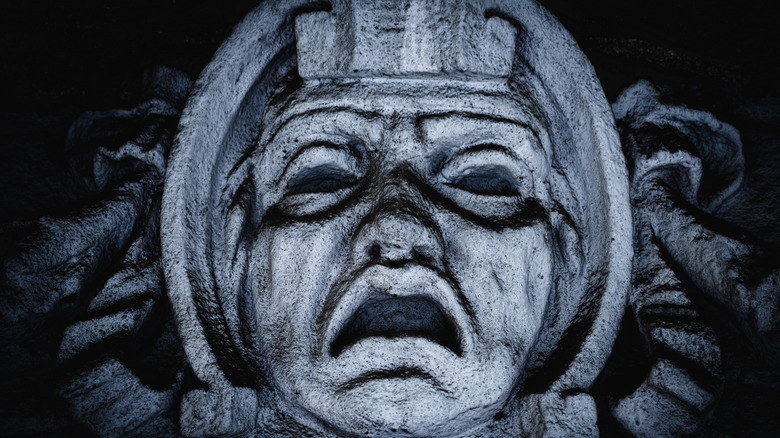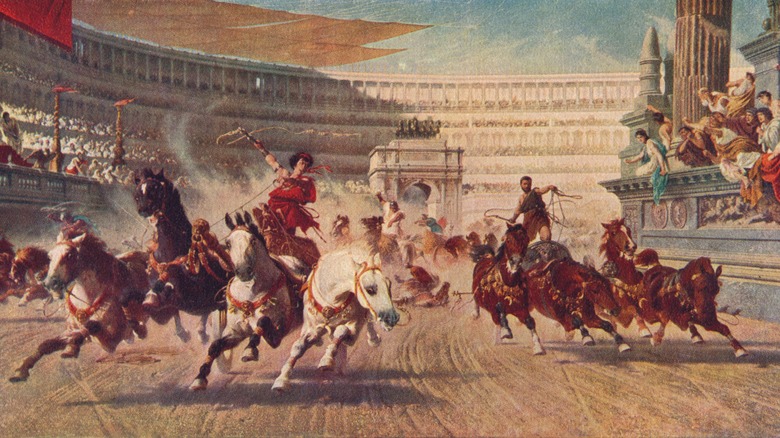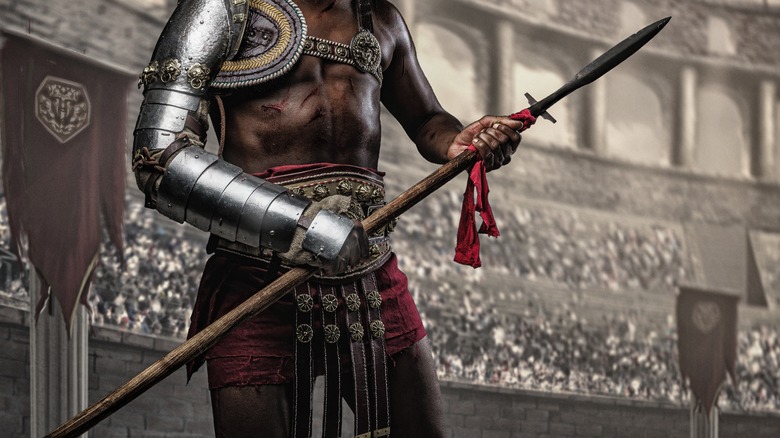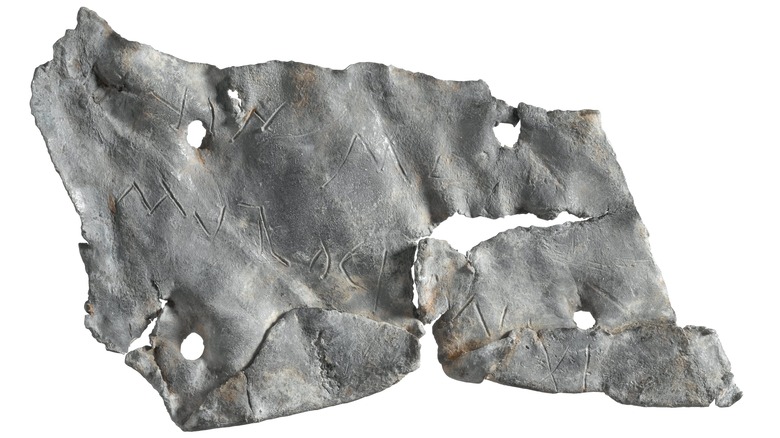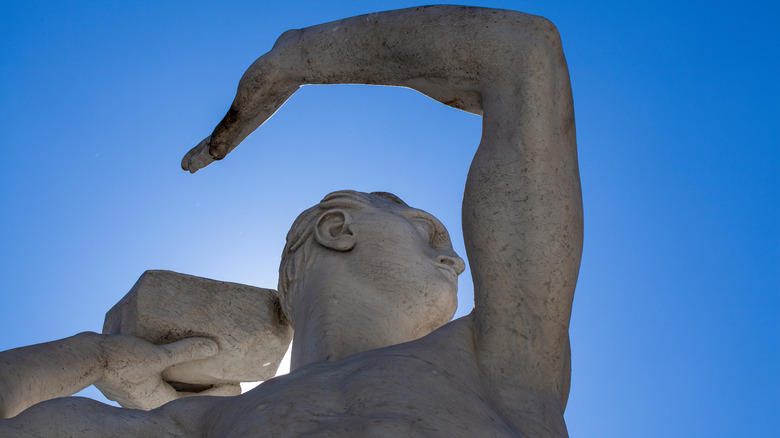Why Roman Gladiator Fights Spawned Countless Curse Tablets
So you know how some people go bonkers over their favorite sports and teams, as though their entire identity and life are invested in a proxy victory over foes? News flash: things have never been any different. Ancient Rome, the civilization on which so, so many modern institutions are based, was bananas about sports. The Flavian Amphitheater, aka the Colosseum, is the model for all of our present-day athletic venues, where seats for fans encircle the arena on all sides. The Colosseum was used for theater, historical reenactments, parade openings, animal hunts, executions, gladiator fights, and more, as Live Science explains. Meanwhile, the Circus Maximus, used for chariot racing, could seat 150,000 people and was as long as six American football fields, per Rome Site.
With so much public investment in sports, you can bet Rome's urban masses took advantage of athletic events as much as possible. Rome's population — reaching 1,000,000 at its highest, per the United Nations of Roma Victrix — was crammed into small, boxed apartments, worked themselves to the bone, and had limited education and literacy rates, per Wondrium Daily and the University of Michigan. Sometimes all they really wanted was to see gladiator A smash the crap out of gladiator B. Sound familiar?
Like now, folks back then sought any and all advantages for their favorite sports heroes and teams. They were also highly superstitious and tried to sabotage sporting events in a way that might seem extreme to us, even a bit bizarre: curses.
An entire hex-and-curse industry
Roman love of hexing and cursing goes far, far beyond what you might imagine, as "Living and Cursing in the Roman West" describes. Cursing wasn't something done under your breath if someone cut you off on the street — it was professional. People wrote their curses down on parchment, fabric, stone tablets, or used bits of metal, pottery, or stone-like wedges of torn napkins. They inscribed hideous, savage wishes for pain, gore, and death. If they were illiterate, they went to professional curse writers — an actual profession — and commissioned what they needed.
And make no mistake, these are no paltry, piddling curses like, "Poo on you, dummy-head." As Mental Floss cites, one curse reads, "The human who stole Verio's cloak or his things, who deprived him of his property, may he be bereft of his mind and memory, be it a woman or those who deprived Verio of his property, may the worms, cancer, and maggots penetrate his hands, head, feet, as well as his limbs and marrows." Another curse reads, "May the person who carried off Vilbia from me become liquid as the water. May she who has so obscenely devoured her be struck dumb." Sports-related curses were especially brutal, like, "I implore you, spirit, whoever you are, and I command you to torment and kill the horses of the green and white teams from this hour on, from this day on, and to kill Clarus, Felix, Primulus, and Romanus, the charioteers."
Rabid sports fans unite
Let's circle back to the Roman love of sports, which might have outstripped even their love of curses. First off, bear in mind that "ancient Rome" was split into separate periods: republic (509 to 27 B.C.E., per Live Science) and empire (27 B.C.E. to about 393 C.E., per the Metropolitan Museum of Art). Rome's beginning and end dates are also up for debate. The mythological founding date of Rome was 753 B.C.E., per World History Encyclopedia. The Byzantine Empire — the break-off eastern half of Rome — finally died in 1453 C.E., per History. All this is to say: You could imagine how much culture, traditions, habits, etc., could change over 2,200 years of history. What we describe in this article comprises an overall, generalized portrait.
That being said, it's safe to say that Romans were 100% invested in sports. Tickets were often free, and people would flock in droves, especially to chariot races. Like today, teams were worshipped, and some athletes became mega-rich celebrities, per World History Encyclopedia. Smithsonian Magazine describes chariot teams divided by colors: the Reds, the Whites, the Greens, and the Blues. Fans were extremely devoted to their teams and might riot for days if their team lost. Wondrium Daily reports that the city of Thessaloniki burned down in such a riot in 390 C.E., and 7,000 people were arrested. Exactly what lengths do you figure such fans would go through to ensure their favorites won? If you said "curses," you're completely correct.
That gladiator life
Chariot racing might have been the most common Roman sport, but gladiator fights were where Roman love of spectacle and bloodshed reached fever pitch. Most folks nowadays know about gladiators, no thanks in small part to movies like 1960's "Spartacus" and 2000's "Gladiator." These films get some things right and some things wrong. For example, yes, gladiators were enslaved. As ThoughtCo. describes, they trained in specific weapon-and-armor classes like retiarius (plural of retiarri), who fought with a trident and net, or thraces (plural of traex), who wore full body armor and had a tiny shield and curved sword. Gladiators trained at schools, ate a vegetarian diet, received a wooden sword called a rudis when they retired or were freed, and so on.
However, gladiators didn't fight very often. Discover Magazine says that they fought maybe three to five times a year, if that. Gladiatorial combat was a special event reserved for certain occasions, in part because gladiators were so expensive to buy and train. As History Collection says, gladiators were rented from schools for fights, and if they died, it cost the school quite a lot. Gladiators were also idolized as symbols of sexual power. Wealthy women paid to sleep with gladiators, and an entire cottage industry arose to collect gladiator sweat and sell it as an aphrodisiac. All in all, a lot was riding on gladiator fights, even beyond the lives of its competitors. And because gladiator fights were particularly brutal, so were their curses.
Curses to bind, maim, and kill
Because gladiator fights were life and death events, their curse tablets — defixiones, by the official term — often sought to outright murder particular gladiators. As Georgetown University says, nine curse tablets were found at the Carthage Amphitheater alone, a venue that specialized in gladiator versus animal fights. One curse asks "the spirits" to "kill, drive off, wound Gallicus, whom Prima bore, in this very hour in the circle of the amphitheater." It also protects animals from his attacks, "so that he will not be able to kill a bear or a bull with a single blow, nor with two blows at a time shall he kill, nor with three blows will he will able to kill a bull or bear." Another tablet seeks to "bind three sons of one Aemilianus" within two days of its writing, and another to pull a gladiator into "the infernal dwelling" of the underworld.
As for how the curses were deployed, the defixiones at the Carthage Amphitheater provide a good example: They were physically placed in the location of the curse's desired effect. If someone wanted to curse a gladiator, they'd place a curse in an arena "as close to the victim as possible," as Archaeology Expert states. While we're not quite sure if would-be cursers snuck into a venue before an event and slipped a defixio under a bench in a gladiatorial locker room, that's definitely the level of dedication to death we're talking about.
Magic-users, ancient and modern
While it might seem strange for sports fans — because yes, gladiator fights were considered a sport — to draft written curses and deposit them in curse-friendly locations at sporting venues, folks today still engage in all sorts of superstitious, ritualistic behaviors regarding their favorite teams and players. The next time someone is watching an American football game and shrieking, "Go, go, get him, get him!," ask yourself if that's very different from an ancient Roman defixio demanding malicious spirits to, "Go, go, get him, get him!"
As Georgetown University points out, the whole Roman curse industry grew out of ancient beliefs regarding magic. Divination, augury, oracles, prophecy, lucky charms and protective objects, spells, enchantments, magic phrases, and words — these all went hand-in-hand in Roman curse tablets. Mental Floss says that we've uncovered over 1,500 curses across all realms of life. And if that's what we've discovered, you can bet that a whole lot more were written.
At present, some curses have even made it into the UNESCO Memory of the World Register. Found from the 2nd to 4th century C.E. in Bath, England, these curses were written on small pieces of lead or pewter and tossed into the water of a Roman bath. Some were written front-to-back "to increase the curse's potency" or were "pierced with nails." They also contained symbols as well as words. Let's just hope none of them are stored too close to anyone who might be taken for the curse's target.

